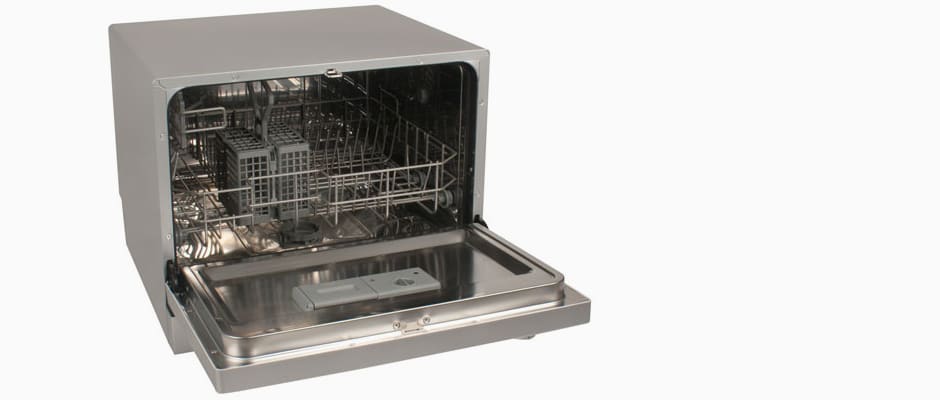Pros
Cons
Introduction
Despite the EdgeStar's size, it does a very good job cleaning dishes. It's so good, in fact, that we've given it the 2012 Best of Year award for Best Compact/Portable Dishwasher. Design aficionados be warned, however: even though it has a stainless steel interior, that front panel is still made of plastic. The faux stainless is about as realistic as a TV show plotline about a robot child.
Design & Usability
{{section_header}}{{section.name}}{{/section_header}}
Since there's only one way you can load it, it's easy to use by default.
On the website where we ordered the Edgestar DWP61ES, its exterior was described as “silver.” In the photo, it looks like it might pass for stainless. It doesn’t. It’s just a matte silver plastic panel, though it is resistant to fingerprints. The stainless inside is pretty classy for a dishwasher in this price range, though, and helps speed up the drying process. Once you start using it, you'll quickly notice this washer's many noises, from the sound of water flowing in to the hum of the pump that pushes dirty water out. Also, it's worth mentioning that the compact nature of the machine means there's only one rack.
If you have a standard kitchen faucet with a twist-off aerator, the Edgestar DWP61ES will connect to it easily. Controls are spread out across the panel; aside from a knob that’s used to select a cycle, there are four plastic membrane keys to activate the device or engage the extra options. One side note: we recommend cleaning the filter after each wash, as it ended up totally clogged after each of our tests.
{{photo_gallery "Front Closed Photo", "Fingerprints Photo", "Controls 1 Photo", "Controls 2 Photo", "Front Open Photo", "Interior Detail Photo", "Top Rack Photo", "Top Rack Detail Photo 1", "Top Rack Detail Photo 2", "Top Rack Detail Photo 3", "Bottom Rack Photo", "Bottom Rack Detail Photo 2", "Bottom Rack Detail Photo 3", "Cutlery Basket Photo", "Cutlery Basket Detail Photo 1", "Cutlery Basket Detail Photo 2", "Cutlery Basket Detail Photo 3"}}
Features
{{section_header}}{{section.name}}{{/section_header}}
The number of extra features is proportional to its compact size. In other words... there aren't many.
The Edgestar DWP61ES has five full wash cycles in addition to a ten minute rinse. We recommend running that rinse cycle if you're going to put the dishwasher in storage—it cleans off the filter and clears out the hoses. There are just two additional features on this washer: a delay wash good for up to 24 hours, and an option to customize a wash to work with all-in-one wash tablets.
Performance
{{section_header}}{{section.name}}{{/section_header}}
Calling this the little washer that could would be an insult. This is the little washer that can and did.
Normally, compact units require lengthier time spans to do the same job as a full-sized machine. This one didn't—more or less—perhaps due to the reduced internal capacity. Even in the face of full-sized filth the Edgestar DWP61ES did an admirable job getting dishes clean: the Normal cycle did just as well as any mid-range full-sized dishwasher, while the Speed cycle is perfectly adequate for lightly soiled dishes. The tiny rack and restrictive tines means you won't be able to wash many large items at once, but at least you can take comfort in the excellent performance of the Heavy cycle.
Conclusion
{{section_header}}{{section.name}}{{/section_header}}
A small price tag for a small appliance that delivers big on performance.
For when you just don't have room in the kitchen, the Edgestar DWP61ES is a portable dishwasher that, incredibly, outperforms some full-sized models. It's very good at getting the job done, and a heck of a lot cheaper than hiring a kitchen staff. Its price tag matches its diminutive size, with an MSRP of $389.99. There are sale prices that drop it down even lower, too: you can easily find an online retailer selling one for about $219.
Science Introduction
{{section_header}}{{section.name}}{{/section_header}}
It may be hard to believe, but the numbers don't lie. Take a closer look at our data pertaining to the Edgestar DWP61ES.
Performance
{{section_header}}{{section.name}}{{/section_header}}
Given the history of compacts, it's hard to believe that this machine did so well.
The Speed cycle had no problem with tea or egg stains, but oat flakes and a bit of the minced meat remained behind. That kind of thing isn't unheard of with a quick wash, though. The Normal cycle did even better, removing almost everything including the meat; it had a little but of trouble with the spinach stains, however.
Despite the spatial issues when loading large items, there was no trace of baked-on lasagna or burnt crème brûlée at the end of the Heavy Duty cycle, but some cheese did stay stuck on one pan. Speaking of spatial issues, it's worth mentioning that compact appliances often take longer than their full-sized counterparts. This wasn't the case here: while the countdown timer was a bit misleading, generally speaking, cycles were quite short and efficient. The fastest cycle—Speed—took 53 minutes, while the longest—Heavy—took about an hour and 43.
{{photo_gallery "Science Section 1 Images"}}
Efficiency
{{section_header}}{{section.name}}{{/section_header}}
This tiny machine will take up about as much space on your utility bill as it will in your kitchen.
The EdgeStar relies on hot water input. Though it has internal heating elements, it doesn’t get water much past 148ºF. That means less energy is used by the appliance itself for heating water. Cycles used between 0.26 and 0.51 kWh of electricity per wash. The small wash tub also means you only need a small amount of water to fill it: cycles used between 2.56 and 3.82 gallons of water, which is probably less than you would use to hand wash your plates. An average year of running the Edgestar DWP61ES would set you back a total of $18.37 in water and electricity.
{{photo_gallery "Science Section 2 Images"}}
Capacity
{{section_header}}{{section.name}}{{/section_header}}
Tines were rather close together, hurting overall capacity.
Its manual said the Edgestar DWP61ES could fit six place settings, but we found that poorly-placed tines and fixed rack space limited us to four. This isn’t a particularly tall machine, so your capacity will fall even more if you’re trying to wash a large item; limited height means you'll have to lie it down flat.
{{photo_gallery "Science Section 3 Images"}}
Meet the tester
Keith was the Editor in Chief of Reviewed's appliance and automotive sites. His work has appeared in publications such as Wired, Car & Driver, and CityLab.
Checking our work.
Our team is here to help you buy the best stuff and love what you own. Our writers, editors, and experts obsess over the products we cover to make sure you're confident and satisfied. Have a different opinion about something we recommend? Email us and we'll compare notes.
Shoot us an email



